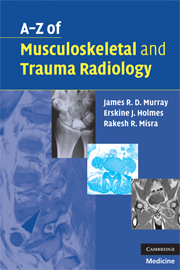Book contents
- Frontmatter
- Contents
- Acknowledgements
- Preface
- List of abbreviations
- Section I Musculoskeletal radiology
- Achilles tendonopathy/rupture
- Aneurysmal bone cysts
- Ankylosing spondylitis
- Avascular necrosis – osteonecrosis
- Femoral-head osteonecrosis
- Kienböck's disease
- Back pain – including spondylolisthesis/spondylolysis
- Bone cysts
- Bone infarcts (medullary)
- Charcot joint (neuropathic joint)
- Complex regional-pain syndrome
- Crystal deposition disorders
- Developmental dysplasia of the hip (DDH)
- Discitis and vertebral osteomyelitis
- Disc prolapse – PID – ‘slipped discs’ and sciatica
- Diffuse idiopathic skeletal hyperostosis (DISH)
- Dysplasia – developmental disorders
- Enthesopathy
- Gout
- Haemophilia
- Hyperparathyroidism
- Hypertrophic pulmonary osteoarthropathy
- Irritable hip/transient synovitis
- Juvenile idiopathic arthritis
- Langerhans-cell histiocytosis
- Lymphoma of bone
- Metastases to bone
- Multiple myeloma
- Myositis ossificans
- Non-accidental injury
- Osteoarthrosis – osteoarthritis
- Osteochondroses
- Osteomyelitis (acute)
- Osteoporosis
- Paget's disease
- Perthes disease
- Pigmented villonodular synovitis (PVNS)
- Psoriatic arthropathy
- Renal osteodystrophy (including osteomalacia)
- Rheumatoid arthritis
- Rickets
- Rotator-cuff disease
- Scoliosis
- Scheuermann's disease
- Septic arthritis – native and prosthetic joints
- Sickle-cell anaemia
- Slipped upper femoral epiphysis (SUFE)
- Tendinopathy – tendonitis
- Tuberculosis
- Tumours of bone (benign and malignant)
- Section II Trauma radiology
Discitis and vertebral osteomyelitis
from Section I - Musculoskeletal radiology
Published online by Cambridge University Press: 22 August 2009
- Frontmatter
- Contents
- Acknowledgements
- Preface
- List of abbreviations
- Section I Musculoskeletal radiology
- Achilles tendonopathy/rupture
- Aneurysmal bone cysts
- Ankylosing spondylitis
- Avascular necrosis – osteonecrosis
- Femoral-head osteonecrosis
- Kienböck's disease
- Back pain – including spondylolisthesis/spondylolysis
- Bone cysts
- Bone infarcts (medullary)
- Charcot joint (neuropathic joint)
- Complex regional-pain syndrome
- Crystal deposition disorders
- Developmental dysplasia of the hip (DDH)
- Discitis and vertebral osteomyelitis
- Disc prolapse – PID – ‘slipped discs’ and sciatica
- Diffuse idiopathic skeletal hyperostosis (DISH)
- Dysplasia – developmental disorders
- Enthesopathy
- Gout
- Haemophilia
- Hyperparathyroidism
- Hypertrophic pulmonary osteoarthropathy
- Irritable hip/transient synovitis
- Juvenile idiopathic arthritis
- Langerhans-cell histiocytosis
- Lymphoma of bone
- Metastases to bone
- Multiple myeloma
- Myositis ossificans
- Non-accidental injury
- Osteoarthrosis – osteoarthritis
- Osteochondroses
- Osteomyelitis (acute)
- Osteoporosis
- Paget's disease
- Perthes disease
- Pigmented villonodular synovitis (PVNS)
- Psoriatic arthropathy
- Renal osteodystrophy (including osteomalacia)
- Rheumatoid arthritis
- Rickets
- Rotator-cuff disease
- Scoliosis
- Scheuermann's disease
- Septic arthritis – native and prosthetic joints
- Sickle-cell anaemia
- Slipped upper femoral epiphysis (SUFE)
- Tendinopathy – tendonitis
- Tuberculosis
- Tumours of bone (benign and malignant)
- Section II Trauma radiology
Summary
Characteristics
Pure discitis (infection limited to the intervertebral disc) is rare. More commonly, the infection is within the adjacent veterbrae (osteomyelitis) and spreads into the disc rather than vice versa; however, the end-plates of the adjacent vertebrae are rapidly attacked in cases of primary discitis.
Most cases of discitis are iatrogenic, following disc injection (discography or chemonucleolysis) or surgical excision (discectomy). Discitis is rarely secondary to haematogenous spread.
With osteomyelitis, the source of infection is either from spinal procedures (including spinal or epidural injection) or systemic infection, most commonly pelvic infection.
The commonest organism is Staphylococcus aureus (50%–60%), although Gram-negative organisms, particularly E coli, Proteus and Pseudomonas, are increasingly pathogenic.
In immunocompromised patients expect opportunistic pathogens. Tuberculosis must be considered in spinal infection, particularly with no history of recent spinal procedure, and in immunocompromised hosts.
Clinical features
History of an antecedent invasive procedure or, with secondary discitis/osteomyelitis, a recent systemic infection.
Pain localised to the particular spinal segment, but do not forget that spinal infection can track down muscle planes to present as groin or buttock abscesses. Spinal muscle spasm may also be present.
Examination may reveal mild temperature or tachycardia. The relevant spinal segment is usually tender to palpation.
CRP, ESR and white-cell count should be raised.
Radiological features
Location: L3/4 and L4/5; unusual above T9 and usually involvement is limited to one disc space.
Radiographs – plain films are usually positive 2–4 weeks after onset of symptoms – decrease in disc height, indistinct end plates with destructive end plate sclerosis.
CT – paravertebral inflammatory mass and extension into the epidural space.
Nuclear medicine – positive before radiographic change, with increased uptake in the disc and adjacent vertebrae; however suffers from poor sensitivity (40%).
[…]
- Type
- Chapter
- Information
- A-Z of Musculoskeletal and Trauma Radiology , pp. 45 - 48Publisher: Cambridge University PressPrint publication year: 2008



